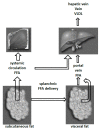Fat depots, free fatty acids, and dyslipidemia
- PMID: 23434905
- PMCID: PMC3635208
- DOI: 10.3390/nu5020498
Fat depots, free fatty acids, and dyslipidemia
Abstract
Body fat deposition and excess free fatty acid (FFA) metabolism contribute to dyslipidemia and the adverse health consequences of obesity. Individuals with upper body obesity have impaired functioning of adipocytes, the primary fatty acid storage site. Excess visceral fat is strongly associated with impaired suppression of FFA release in response to insulin, as well as with hypertriglyceridemia and low concentrations of high density lipoprotein (HDL) cholesterol. High FFA concentrations can induce insulin resistance in muscle and liver. Furthermore, failure of hyperinsulinemia to normally suppress FFA is associated with impaired carbohydrate oxidation and muscle glucose storage, reduced hepatic insulin clearance and elevated triglycerides. Understanding the impact of body fat distribution on FFA metabolism and dyslipidemia is critical for determining the link between overweight and obesity and cardiovascular disease risk. In the current review, we will explore the relationship between adipose tissue, body fat depots, and FFA metabolism.
References
Publication types
MeSH terms
Substances
LinkOut - more resources
Full Text Sources
Other Literature Sources


